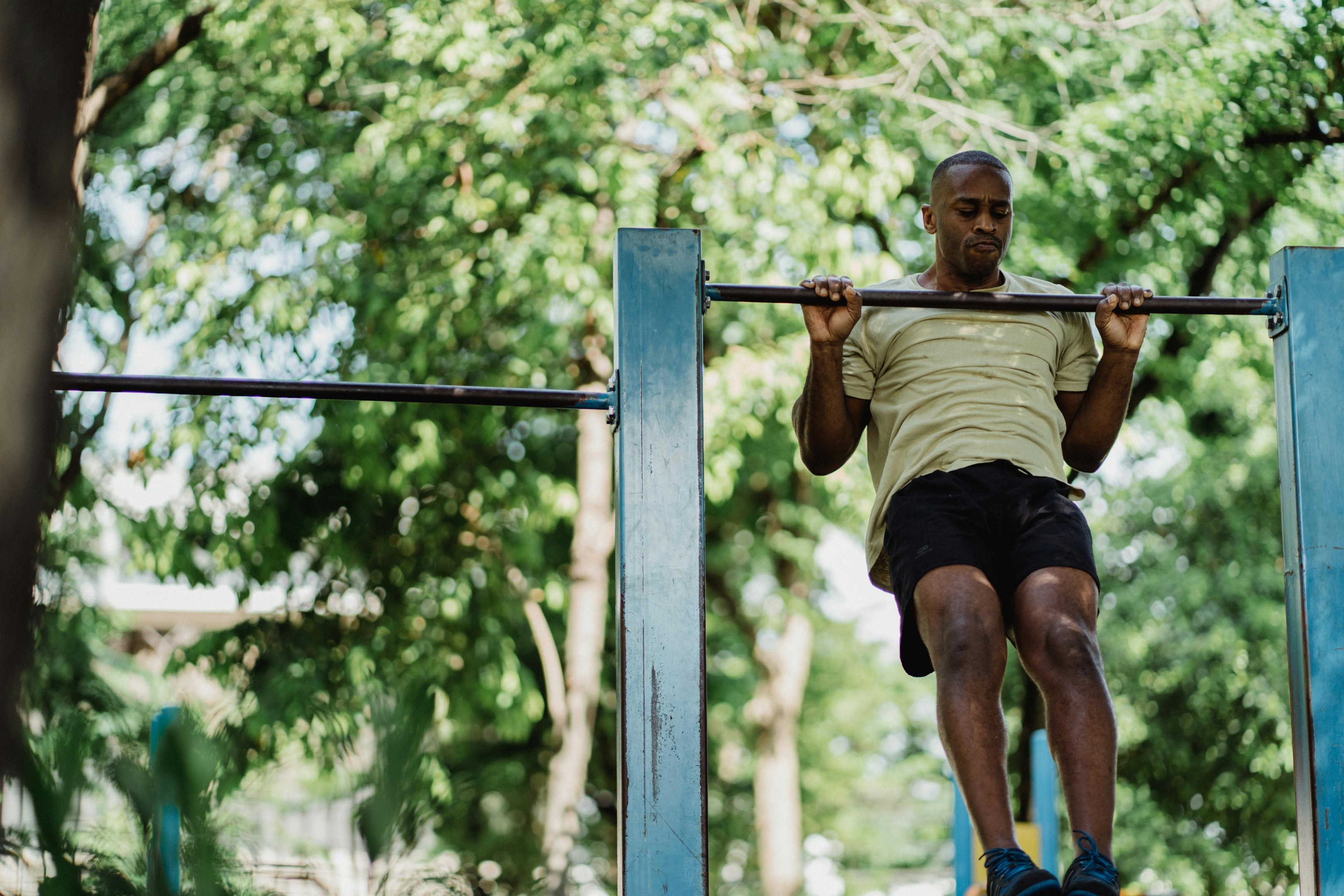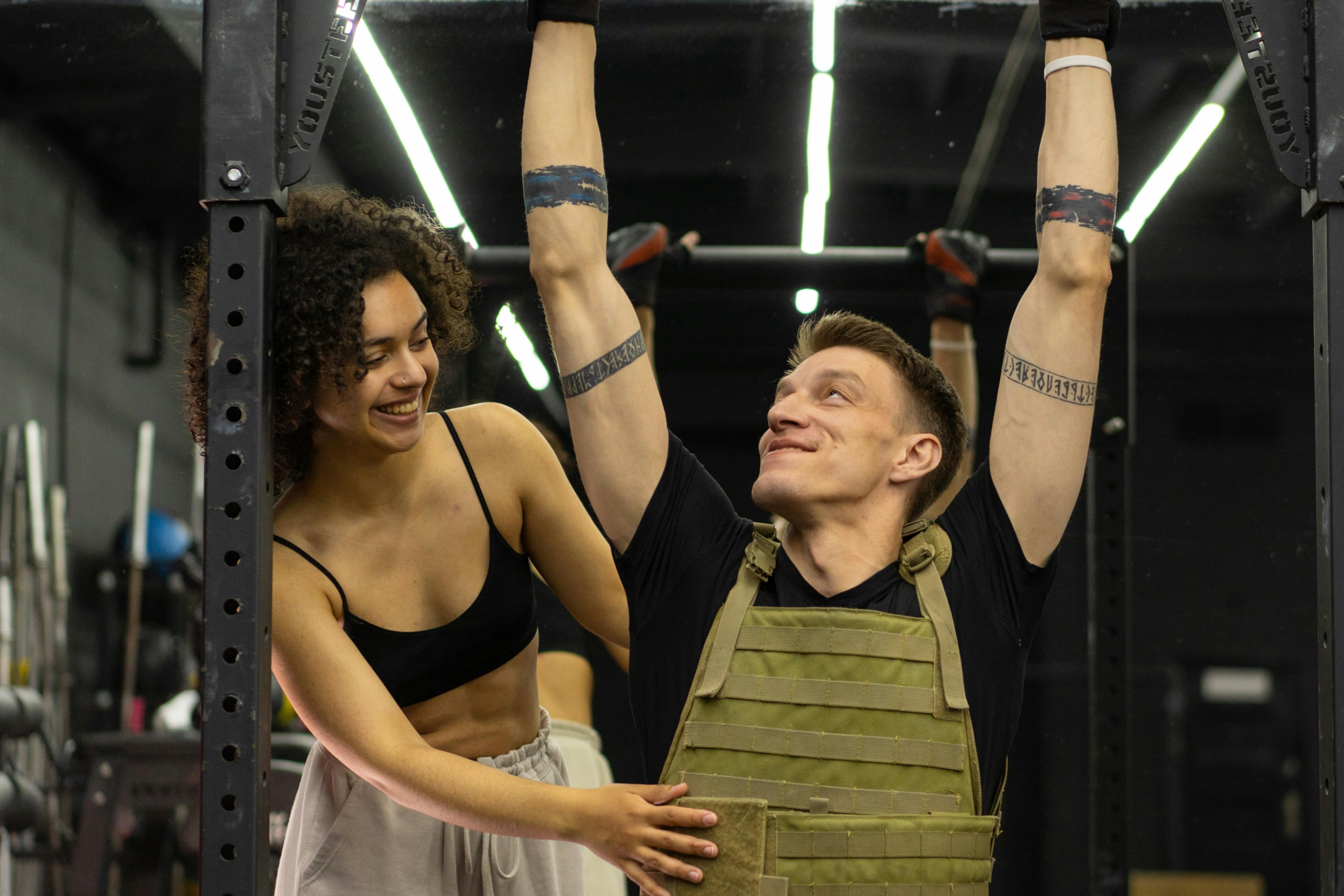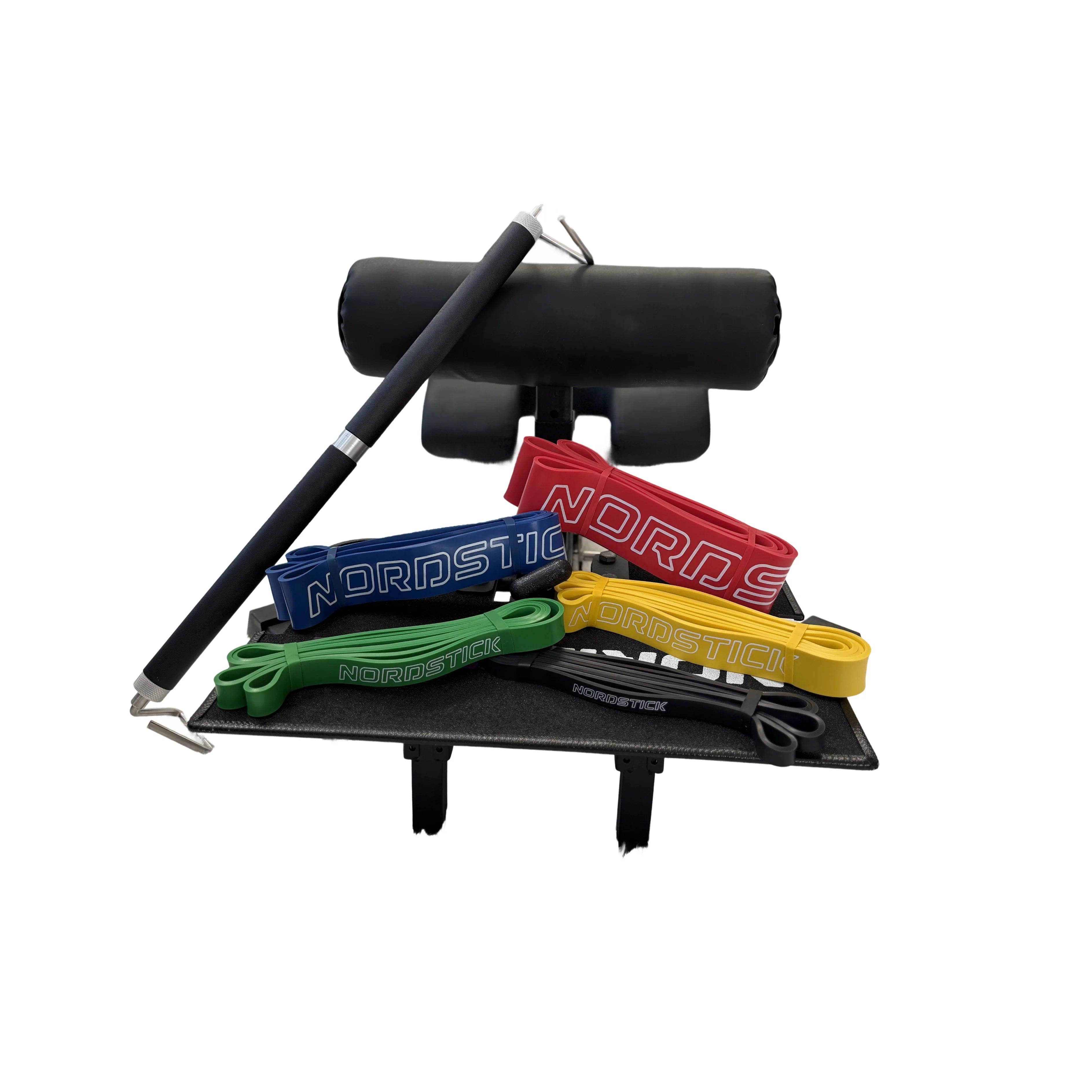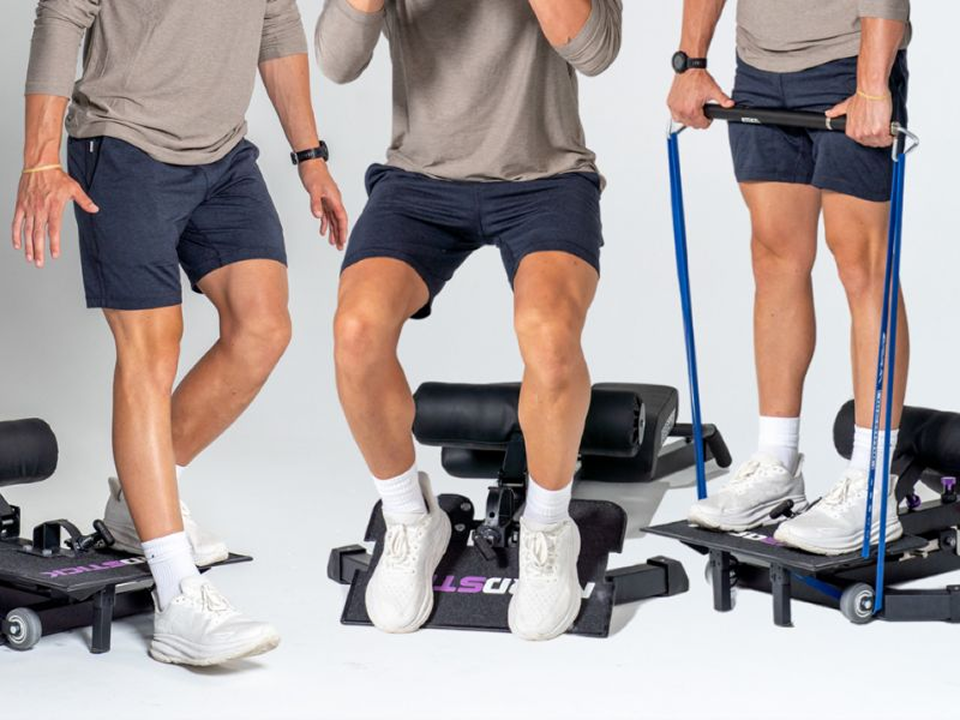Pull-ups are an awesome full-body exercise that packs a punch for your fitness routine. Whether you're just starting out or a home workout pro, landing that first pull-up is a huge win! Let's embark on this journey together with simple, actionable steps to gain the upper body and core strength you need. From choosing the right pull-up bar to nailing that dead hang position, we've got you covered with everything you need to know.
Key Takeaways
- Master the basics first: Building foundational strength with exercises like rows, dead hangs, and band-assisted pull-ups will help you work up to your first full pull-up.
- Focus on technique: Proper form is key to achieving a pull-up—engage your core, use your back muscles, and avoid relying solely on your arms to pull yourself up.
- Consistency leads to results: Regular practice, combined with progressive overload, will gradually build the strength needed to complete your first pull-up.
Why Are Pull-Ups Important?
Pull-ups are a powerhouse exercise that significantly boosts overall fitness and strength. They engage multiple muscle groups, including the back muscles, shoulders, arms, and core. This compound movement is a major benefit because it builds upper body strength efficiently.
Pull-ups also enhance grip strength as you support your entire body weight throughout the movement. Besides physical strength, pull-ups improve functional fitness skills like climbing and lifting. They engage the core for stability, which promotes better posture and balance.
Additionally, regularly practicing pull-ups can lead to increased muscle mass and more defined muscles over time. They are versatile and adaptable, accommodating variations like chin-ups and negative pull-ups to suit different fitness levels.

What Equipment Do I Need for Pull-Ups?
The most crucial item is a pull-up bar. These bars can be mounted in doorways, on walls, or as part of a free-standing structure. When selecting a pull-up bar, ensure it's sturdy and can support your body weight. An adjustable bar is beneficial, allowing you to practice different grips, like overhand and underhand grips.
Optional aids can make the exercise easier, especially for beginners. Resistance bands offer support by reducing the weight you lift during the pull-up. Simply loop them over the bar and place your knees or feet in the band for assistance.
An assisted pull-up machine, commonly found at gyms, can also help by providing adjustable counterweight support. Additionally, wrist straps or gloves can enhance grip strength and comfort, especially during longer sessions. With the right equipment, you'll be well-equipped to get your first pull-up.

How Should I Prepare for My First Pull-Up?
General conditioning tips
Before you attempt your first pull-up, focus on building a foundation of overall strength and conditioning. Start with exercises that target the upper body and core, such as push-ups and planks. These will enhance your shoulder, chest, and core strength, supporting the pull-up movement. Incorporate dumbbell rows to strengthen your back muscles and improve pulling strength.
Additionally, practice maintaining tension in your body by engaging in exercises like hollow holds and dead hangs. These will help you control your body weight and develop core stability. Ensure your conditioning routine includes exercises that increase grip strength, like farmer's carries or towel pull-ups.
Conditioning isn’t just about strength; it's also about mobility. Work on shoulder mobility exercises to ensure a full range of motion. Consistency is key, so integrate these exercises into your training program regularly. This approach will prepare your body for the demands of a pull-up.

Exercises to strengthen relevant muscles.
To prepare for your first pull-up, focus on exercises that target the muscle groups involved in the movement. Begin with lat pull-downs to isolate and strengthen the latissimus dorsi, a primary muscle used in pull-ups. Another effective exercise is the bodyweight row, which mimics the pull-up motion and engages the back muscles and biceps.
Incorporate negative pull-ups into your routine. Start in the top position of a pull-up and slowly lower yourself in a controlled manner. This exercise improves strength and builds muscle memory. Flexed arm hangs are also beneficial; hold your chin above the bar for as long as possible to enhance your pulling strength and endurance.
Strengthen your core with hollow body holds and planks, which promote the hollow position required for pull-ups. Lastly, include shoulder exercises like overhead presses and lateral raises to stabilize and support the entire movement. These exercises will collectively build the strength needed for your first pull-up.

What Techniques Help Achieve a Pull-Up?
Proper form and techniques
Mastering the proper form and techniques is crucial for performing a standard pull-up effectively and safely. Begin with a shoulder-width grip on the pull-up bar, with your palms facing away from you. Engage your core by maintaining a hollow body position, keeping your legs straight, and your abs tight. This helps maintain tension throughout the movement.
Start from a dead hang position, where your arms are fully extended, and your shoulder blades are down and back, as if tucking them into your back pockets. As you pull yourself up, focus on drawing your elbows down toward your sides, ensuring that your chest moves towards the bar. Keep your movement controlled, avoiding any swinging or jerking.
At the top position, your chin should be over the bar. Lower yourself back to the starting position in a controlled manner, extending your arms fully. Practicing these techniques will lead to a more efficient and injury-free pull-up journey.

What Are the Best Exercises to Strengthen for Pull-Ups?
Exercises that target the muscles used in pull-ups.
Focusing on exercises that strengthen the muscles used in pull-ups will accelerate your progress. Start with lat pull-downs to directly engage the latissimus dorsi, crucial for pulling strength. Use a wide grip to mimic the pull-up bar's overhand grip.
Incorporate bent-over rows and dumbbell rows to target the mid-back and biceps, both essential for pulling movements. These exercises help build muscle mass and enhance the pulling motion required for pull-ups.
Practice dead hangs and flexed arm hangs to improve grip strength and endurance. These exercises condition your forearms and hands, making it easier to hold your own bodyweight during pull-ups.
Tackle core strength with exercises like hanging leg raises and planks. A strong core provides stability during the pull-up movement, allowing for better form. Finally, shoulder exercises, such as overhead presses, help stabilize the shoulder joint, essential for safe and effective pull-ups. Engaging these exercises regularly will fortify the muscle groups needed for a successful pull-up.

How Can I Progress if I Can't Do a Single Pull-Up?
Progression strategy for beginners
If you're struggling to perform a single pull-up, don't worry. A structured progression strategy can help you gradually build the necessary strength. Begin with band assisted pull-ups. Use resistance bands to reduce the amount of body weight you pull, allowing you to focus on proper form. As you gain strength, switch to lighter bands.
Negative pull-ups are another essential exercise. Start at the top position of the pull-up and slowly lower yourself in a controlled manner. This builds strength in the same muscle groups used for the full pull-up.
Incorporate jumping pull-ups into your routine. Use your legs to jump into the pull-up, then focus on the controlled descent. This helps build pulling strength and muscle memory.
Additionally, practice assisted pull-ups using an assisted pull-up machine, if available. These machines let you adjust the counterweight, gradually increasing the difficulty as you gain strength. Consistent practice with these exercises will set you on the path to achieving your first pull-up.

Assisted variations
Assisted variations are a practical way to bridge the gap between being unable to do a pull-up and achieving your first unassisted rep. Band assisted pull-ups are a popular choice. By looping a resistance band over the pull-up bar and placing your foot or knee inside, you reduce the amount of body weight you lift. This allows you to work on your form and strength simultaneously.
The assisted pull-up machine is another excellent tool. Found in many gyms, it provides adjustable counterweight support, enabling you to perform the pull-up motion with reduced body weight.
Jumping pull-ups are an effective alternative. Use a slight jump to help propel your body upward, focusing on controlling the descent. This helps build crucial pulling strength over time.
Additionally, partner-assisted pull-ups can be beneficial. A workout partner can support your legs or waist, providing just enough assistance to complete the movement. These variations allow you to practice the entire movement while gradually building the necessary strength.

How Often Should I Practice Pull-Ups?
Suggested training schedule
A well-structured training schedule is key to progressing in your pull-up journey. Aim to practice pull-ups two to three times a week, allowing for rest days in between sessions to facilitate muscle recovery and growth. On pull-up days, start with a warm-up to activate the upper body and core muscles.
Begin with 3-4 sets of assisted pull-ups or negative pull-ups, focusing on form and control. Follow this with exercises targeting supporting muscles, such as dumbbell rows or lat pull-downs. Incorporate core exercises like planks or hanging leg raises to round out your session.
On non-pull-up days, engage in complementary workouts that bolster overall strength, such as push-ups, dead hangs, or bodyweight rows. Rest days are essential for recovery, so avoid overtraining by listening to your body.
Every few weeks, reassess your progress and adjust the difficulty of your exercises, gradually reducing assistance as your strength increases. This balanced approach ensures consistent progress without risking injury.
The importance of rest and recovery.
Rest and recovery are crucial components of any training program, including your pull-up journey. As you practice pull-ups and related exercises, your muscles undergo stress and micro-tears. Rest days allow your body to repair and strengthen these muscles, leading to gains in muscle mass and overall strength.
Incorporate at least 48 hours of rest between intense pull-up sessions to optimize recovery. During this time, focus on active recovery activities like walking, yoga, or gentle stretching to maintain mobility without overstraining your muscles.
Proper nutrition supports recovery. Ensure your diet includes sufficient protein for muscle repair and carbohydrates for energy replenishment. Hydration is also key to maintaining muscle function and reducing fatigue.
Adequate sleep is another vital element of recovery, aiding in muscle repair and energy restoration. Aim for 7-9 hours of quality sleep per night. Emphasizing rest and recovery in your routine helps prevent overtraining, reduce injury risk, and ensure steady progress towards achieving your first pull-up.

Are There Common Mistakes to Avoid?
Typical errors beginners make and how to correct them.
One typical error is using momentum or swinging the body to complete a pull-up. This reduces the exercise's effectiveness and increases injury risk. Focus on maintaining a controlled manner throughout the movement, using only your muscles to lift your body.
Another mistake is neglecting to engage the core. A strong core stabilizes the body, ensuring better form and efficiency. Practice maintaining a hollow body position during the pull-up to correct this.
Grip errors are also common, such as holding the bar too tightly or placing the hands too close or too wide. Aim for a shoulder-width grip to optimize muscle engagement.
Lastly, beginners often overlook the importance of shoulder blade positioning. Ensure your shoulder blades are engaged and retracted, like tucking them into your back pockets. This technique facilitates proper alignment and reduces strain on the shoulders. Addressing these errors will lead to improved performance and safer pull-ups.

What Are the Signs of Progress?
Recognizing signs of progress in your pull-up journey can be motivating and affirm your training efforts. One clear indicator is an increase in the number of assisted or unassisted pull-ups you can perform. As your strength builds, you'll notice you're able to complete more reps or require less assistance from bands or machines.
Improved control during the lowering phase of negative pull-ups is another sign. If you can descend more slowly and with better form, it shows enhanced muscle strength and engagement.
You might also see an increase in grip strength, evident through longer dead hangs or heavier weights in other exercises like rows. Additionally, you may experience increased muscle mass and definition in your back, shoulders, and arms, reflecting the muscle groups targeted by pull-ups.
Finally, experiencing less fatigue and faster recovery times after workouts indicates growing endurance and fitness. Tracking these signs helps you gauge your progress and adjust your training program accordingly.

Conclusion
Achieving your first pull-up is a rewarding milestone that reflects dedication and growth in your fitness journey. By focusing on strengthening the relevant muscle groups, maintaining proper form, and incorporating effective progression strategies, you can steadily work towards this goal. Remember, patience and consistency are key. A structured training schedule, balanced with adequate rest and recovery, will support your progress and prevent injury.
Along the way, be mindful of common mistakes, correcting them to improve your technique and efficiency. Celebrate signs of progress, whether it's an increase in reps, improved control, or enhanced muscle definition. These achievements not only signify physical growth but also build confidence and empowerment.
Ultimately, the journey to your first pull-up is not just about physical strength, but about resilience and perseverance. Embrace each step of the process, and you'll not only achieve your goal but also set a strong foundation for future fitness endeavors. Keep pushing forward, and unlock your full potential.

FAQs
Is the first pull-up the hardest?
For many of us, that first pull-up is a real uphill battle. It’s like conquering a mountain of strength and technique, especially if you’re just starting out and still building up those muscles and coordination. Lifting your whole self up using just your upper body is no small feat—it’s all about strength and knowing the right form.
Getting to that first pull-up can seem tough because you've got to nail down stuff like grip strength, core stability, and figuring out how to get a bunch of different muscles to work together. But once you nail that first one, the rest start feeling a bit easier as your muscles catch on and get stronger.
And let’s not forget, hitting this milestone is a huge confidence booster. It sparks motivation, making it easier to push past barriers and add more reps to your count. As you keep practicing, you’ll build up the skills and strength needed for more advanced moves and higher repetitions, taking your fitness journey to the next level.
Should pull-ups be done first?
Whether pull-ups should be done first in your workout depends on your goals. If improving your pull-up count or mastering the movement is a priority, consider doing them at the start of your session. Performing pull-ups first ensures your muscles are fresh, allowing you to focus on form and maximize strength output. This approach can lead to greater improvements in technique and muscle activation.
However, if your workout aims to target multiple areas or includes heavy compound lifts like deadlifts or squats, you might opt to position pull-ups later in your routine. This helps avoid fatigue that could compromise your performance in other demanding exercises.
Ultimately, the best approach depends on your individual goals and overall workout structure. Listening to your body and adjusting accordingly will help you maintain balance and achieve your fitness objectives. Prioritizing pull-ups at the start of your session can be advantageous if mastering this movement is one of your primary goals.









































Leave a comment
This site is protected by hCaptcha and the hCaptcha Privacy Policy and Terms of Service apply.